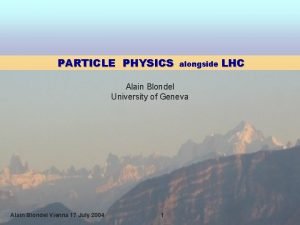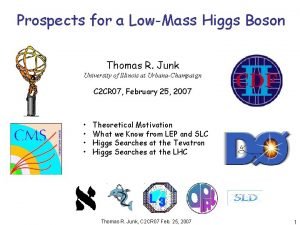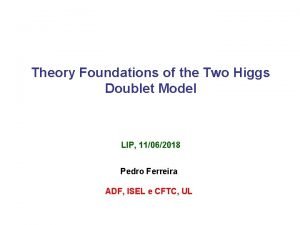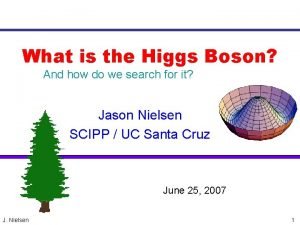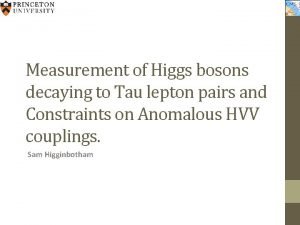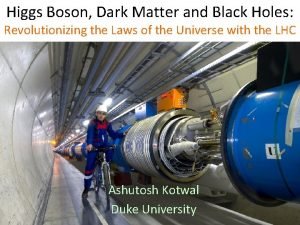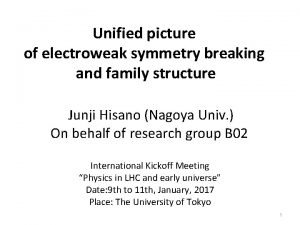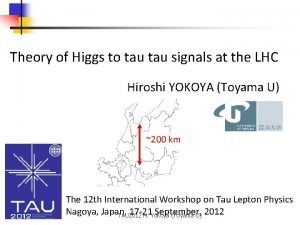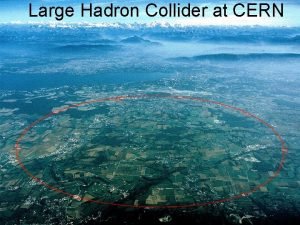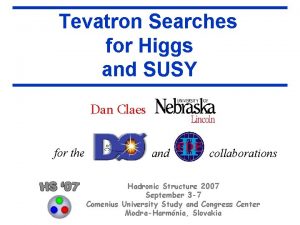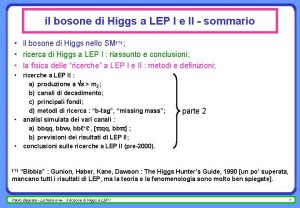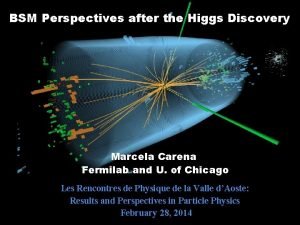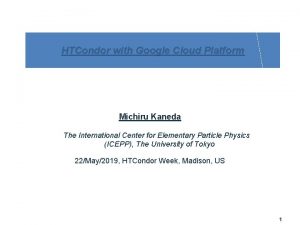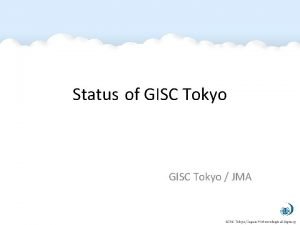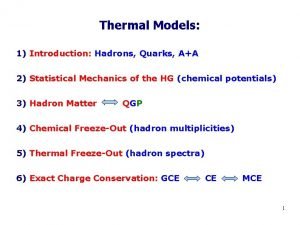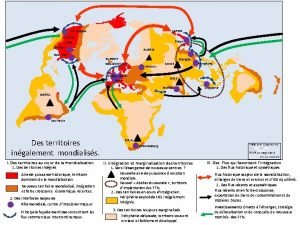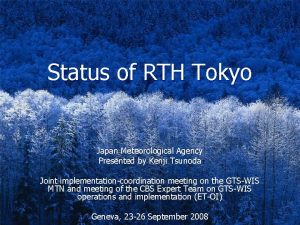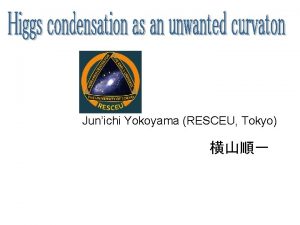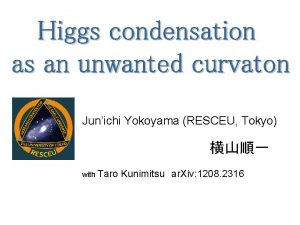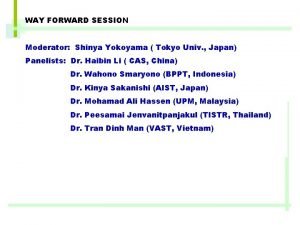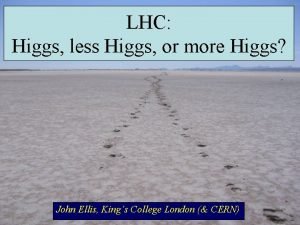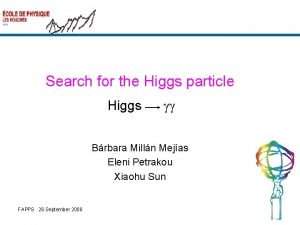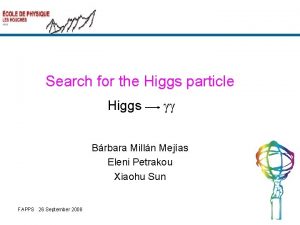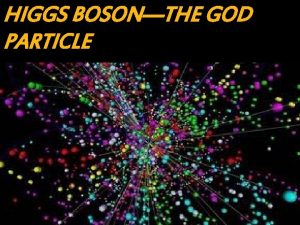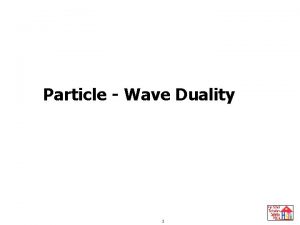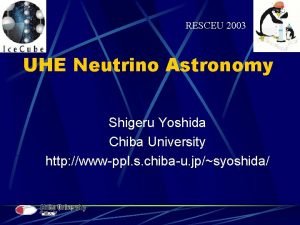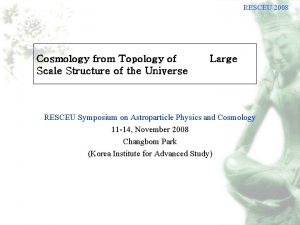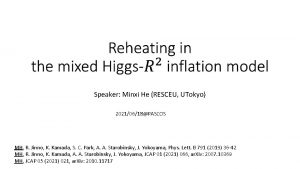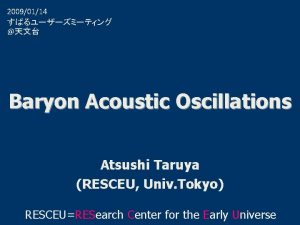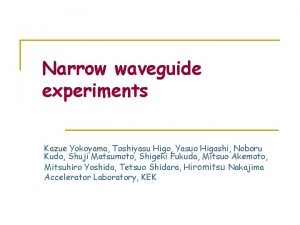Junichi Yokoyama RESCEU Tokyo The SM Higgs particle







































- Slides: 39

Jun’ichi Yokoyama (RESCEU, Tokyo) 横山順一

The SM Higgs particle was finally discovered !? ATLAS 6% human resources, 10% $ from Japan Professor Shoji Asai at the press conference together with his view graph on July 4. CMS A candidate event from a Higgs particle observed by ATLAS (© ATLAS experiment, by courtesy of S. Asai. ) http: //aappsbulletin. org/

What they have found: A scalar particle which interacts with gauge fields. Higgs mechanism seems to be at work. Coupling to quarks and leptons have not been confirmed yet. It is consistent with the Standard Model Higgs, but only half of its roles have been probed. Nevertheless, for Cosmology it is a great discovery, since no one had ever discovered any scalar field until then, which is indispensable for Inflationary Cosmology.

UT Quest Relevance to “Superstring Cosmophysics” ? Now that a Higgs(-like) particle is discovered, any viable superstring theory must accommodate it. I UT Quest progress report “Generalized Higgs inflation” (Kamada, Kobayashi, Takahashi, Yamaguchi, & JY 2012) II “Higgs condensation as an unwanted curvaton” (Kunimitsu & JY 2012)

Just after the CERN seminars in December announcing “hints of the Higgs boson” an analysis of the renormalized Higgs potential was done for m=124~ 126 Ge. V. Elias-Miro et al Phys Lett B 709(2012)222

For there is a finite parameter region within 2σ where the Higgs potential is stable, or its self coupling remain positive even after renormalization.

The simplest possibility tied with the recent experiment: Easy to preach Difficult in practice Tree level action of the SM Higgs field Taking with φ being a real scalar field, we find for This theory is the same as that proposed by Linde in 1983 to drive chaotic inflation at. .

at low energy scale In order to realize we must have . The Higgs potential is too steep as it is. Square amplitude of curvature perturbation on scale The spectral index of the curvature perturbation is given by In potential-driven inflation models

The Higgs potential is too steep as it is. Several remedies have been proposed to effectively flatten the potential. 1 The most traditional one (original idea: Spokoiny 1984 Cervantes-Cota and Dehnen 1995, …. ) introduce a large and negative nonminimal coupling to scalar curvature R Effectively flatten the spectrum

2 New Higgs inflation (Germani & Kehagias 2010) Introduce a coupling to the Einstein tensor in the kinetic term. During inflation If . , the normalization of the scalar field changes. is the canonically normalized scalar field. effectively reducing the self coupling to an acceptable level. (Actual dynamics is somewhat more complicated. )

3: Running kinetic inflation (Takahashi 2010, Nakayama & Takahashi 2010) Introduce a field dependence to the kinetic term. Canonical normalization of the scalar field changes the potential effectively.

(Kamada, Kobayashi, Yamaguchi & JY 2011) Background equations of motion Galileon-type coupling Slow-roll parameters For we find slow-roll EOMs This extra friction term enhances inflation and makes it possible to drive inflation by a standard Higgs field.

Higgs G inflation

In fact, all these models can be described in the context of the Generalized G-inflation model seamlessly, which is the most general single-field inflation model with 2 nd order field equations. Inflation from a gravity + scalar system

In fact, all these models can be described in the context of the Generalized G-inflation model seamlessly, which is the most general single-field inflation model with 2 nd order field equations. Inflation from a gravity + scalar system This theory includes potential-driven inflation models k-inflation model Higgs inflation model New Higgs inflation model G-inflation model

We consider potential-driven inflation in the generalized G-inflation context. So we expand neglect higher orders in X. We find the following identities. (t. d. ) =total derivative As a result we can set in the Lagrangian without loss of generality.

Yet another new model: Running Einstein Inflation simplest case in the generalized G-inflation

We analyze all these possibilities on equal footing, characterizing Higgs inflation by five functions and potential. Potential-driven slow-roll inflation Slow-roll field equation w/ Gravitational field equations

Cosmological Perturbations Tensor perturbation

Scalar perturbations

So far each model has been analyzed separately. G MCMC analysis By Popa 2011 nonminimal new

We can fill the gap using the generalized Higgs inflation

All the Higgs inflation models are unified in the Generalized G-inflation. Open issue: Quantum corrections in the presence of these new interaction terms.

II Cosmology of the Higgs field with Taro Kunimitsu Here we study the case the Higgs field is NOT the inflaton. Whatever the inflation model is, the Higgs field exists in the Standard Model and plays some roles. During inflation, short-wave quantum fluctuations are continuously generated for the Higgs field and its wave length is stretched by inflation to produce zero-mode condensate. Higgs condensation

The most dramatic case Our Universe cannot be reproduced in such a case. (Espinosa et al 2008)

We consider the case λ is positive (and constant) in the regime of our interest. The behavior of a scalar field with such a potential during inflation has been studied using the stochastic inflation method. (Starobinsky and JY 1994) Decompose the scalar field as short-wave quantum fluctuations coarse-grained mode : small parameter

is a solution of namely, A slow-roll equation for the long-wave part obtained from Langevin equation with a stochastic noise term whose correlation function is given by

We can derive a Fokker-Planck equation for the one-point (one-domain) probability distribution function (PDF) Its generic solution can be expanded as is the complete orthonormal set of eigenfunctions of the Schrödinger-type eq. If is finite, we find and the equilibrium PDF exists. Each solution relaxes to the equilibrium PDF at late time which has the de Sitter invariance.

For we find an equilibrium PDF corresponding to as First few eigenvalues (numerically obtained) Equilibrium expectation values obtained using where Higgs condensation

Two point equilibrium temporal correlation function can be well approximated by for The correlation time defined by is given by The spatial correlation function can be evaluated from it using the de Sitter invariance. cf de Sitter invariant separation The spatial correlation length defined by therefore reads Exponentially large ! So we can treat it as a homogeneous field when we discuss its effect on reheating.

Its energy density is small during inflation, but it remains constant until the Hubble parameter decreases to. At this time we find The Higgs field oscillation governed by a quartic potential dissipates its energy density in proportion to in the same way as radiation. So the Higgs condensation or its decay products never contributes to the total energy density in the usual inflation models where inflation is followed by field oscillation of a massive field whose energy density dissipates in proportion to.

In some models, inflation may end abruptly without being followed by its coherent field oscillation and reheating proceeds only through gravitational particle creation. Such inflation models include k-inflation, (original) G-inflation, and quintessential inflation models. In such models the Higgs condensation contributes to the total energy density appreciably in the end. Quintessential inflation (Peebles & Vilenkin 99) A simple k-inflation example (Armendariz-Picon, Damour & Mukhanov 99) : inflaton inflation with

k-inflation kination Free scalar field If this change occurs abruptly, numerical calculation shows that this transition occurs within Hubble time. Gravitational particle production takes place due to this rapid change of the expansion law. The energy density of a massless boson created this way is given by (cf Ford 87) taking at the end of inflation. is the time elapsed during smooth transition from de Sitter to a power-law expansion.

energy density inflation kinatic energy of the inflaton radiation from gravitational particle production time or scale factor is the tensor-scalar ratio.

We incorporate the Higgs condensation. When it starts oscillation @ energy density inflation kinetic energy of the inflaton Higgs condensation Higgs oscillation radiation from Higgs condensation radiation from gravitational particle production time or scale factor

If we try to estimate the reheat temperature from the equality taking the Higgs condensation into account, we find which is to be compared with the previous estimate Thus the Higgs condensate or its decay product contributes to the total energy density appreciably. Its fluctuation can be important.

(Enqvist & Sloth, Lyth & Wands, Moroi & Takahashi 02) Here we analyze properties of fluctuations of the Higgs condensation. A power-law spatial correlation function like can be obtained from a power law power spectrum making use of the formula We find and It practically behaves as a massless free field.

The power spectrum of (potential) energy density fluctuation is given by Amplitude of fractional density fluctuation on scale Its contribution to the curvature perturbation is unacceptably large. can be O(1) Hubble parameter at the onset of oscillation (Kawasaki, Kobayashi & Takahashi 11)

Inflation models followed by kination regime with gravitational reheating is incompatible with the Higgs condensation. Models with such an enhanced spectrum are ruled out. k-inflation Standard inflation Stochastic gravitational wave background from inflation
 Junichi yokoyama
Junichi yokoyama Hungry higgs spil
Hungry higgs spil Higgs factory
Higgs factory Higgs boson
Higgs boson Two higgs doublet model
Two higgs doublet model Higgs boson
Higgs boson Higgs
Higgs Higgs factory
Higgs factory Higgs boson black hole
Higgs boson black hole Higgs singlet
Higgs singlet Higgs to tau tau
Higgs to tau tau Higgs singlet
Higgs singlet Higgs
Higgs Chelsea higgs wise
Chelsea higgs wise Higgs factory
Higgs factory Higgs
Higgs Higgs
Higgs Marcela carena
Marcela carena The tokyo are on
The tokyo are on Angiocholite tokyo 2018
Angiocholite tokyo 2018 Fbu.costa [email protected]
Fbu.costa [email protected] Gisc tokyo
Gisc tokyo Tokyo gce
Tokyo gce Climograph
Climograph Institute of industrial science the university of tokyo
Institute of industrial science the university of tokyo Panje tep
Panje tep Tokyo climate graph
Tokyo climate graph Tokyo disneyland earthquake
Tokyo disneyland earthquake In which hemisphere is japan
In which hemisphere is japan British football academy tokyo
British football academy tokyo Multilateral peering japan
Multilateral peering japan Tokyo climate center
Tokyo climate center Pecha kucha vorlage
Pecha kucha vorlage Tokyo chicago
Tokyo chicago What is the currency of tokyo
What is the currency of tokyo Sinet plans
Sinet plans Dinastia shogun
Dinastia shogun Sputonik
Sputonik Tokyo meteorological agency
Tokyo meteorological agency Quartier tokyo
Quartier tokyo


